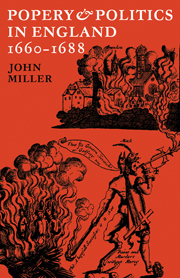Book contents
- Frontmatter
- Contents
- Preface
- Abbreviations
- Note on spellings and dates
- Introduction
- 1 The Catholic laity
- 2 England and Rome: the Catholic clergy
- 3 The penal laws and their enforcement
- 4 The development of the anti-Catholic tradition
- 5 The Restoration settlement and after
- 6 The French alliance and ‘Catholicity’
- 7 York and Danby
- 8 The Popish Plot and the Exclusion Crisis
- 9 The Tory reaction
- 10 James II and the Church of England Men
- 11 James II and the Dissenters
- 12 James II and Rome
- 13 The missionary effort under James II
- 14 The opposition to James II
- Appendices
- Select Bibliography
- Index
5 - The Restoration settlement and after
Published online by Cambridge University Press: 07 October 2011
- Frontmatter
- Contents
- Preface
- Abbreviations
- Note on spellings and dates
- Introduction
- 1 The Catholic laity
- 2 England and Rome: the Catholic clergy
- 3 The penal laws and their enforcement
- 4 The development of the anti-Catholic tradition
- 5 The Restoration settlement and after
- 6 The French alliance and ‘Catholicity’
- 7 York and Danby
- 8 The Popish Plot and the Exclusion Crisis
- 9 The Tory reaction
- 10 James II and the Church of England Men
- 11 James II and the Dissenters
- 12 James II and Rome
- 13 The missionary effort under James II
- 14 The opposition to James II
- Appendices
- Select Bibliography
- Index
Summary
The Restoration settlement confirmed the abolition of some of the institutions abused by Charles I during the personal rule; but it left the crown's prerogatives little diminished, notably in its right to summon and dismiss parliaments and in the ill-defined areas where prerogative action could shade into illegality. In one way Charles II was potentially stronger than the early Stuarts. They had governed under the shadow of the Elizabethan myth, but now there was a new myth, that of the royal martyr. An important section of the political nation never got over the trauma of the Civil War. They remembered sequestration and decimation, the overthrow of the monarchy and of the old political order, the threats to the social order – and they wanted no repetition. Whenever the spectre of another civil war appeared, such men would rally to the crown far more uncritically than their forebears under Charles I would have done. There was thus potential after 1660 for a stronger monarchy, using the ‘Cavalier backlash’.
The monarchy was far from absolute, however. Lacking a large standing army and a politically neutral bureaucracy, the crown had to have a measure of co-operation from those of its subjects who ran the local administration and the militia. Charles II's finances were not constantly bedevilled by inflation as his father's had been, but because of an initially inadequate provision, exacerbated by royal extravagance, he remained for most of his reign financially dependent on parliament, at least for his foreign wars.
- Type
- Chapter
- Information
- Popery and Politics in England 1660–1688 , pp. 91 - 107Publisher: Cambridge University PressPrint publication year: 1973
- 1
- Cited by



